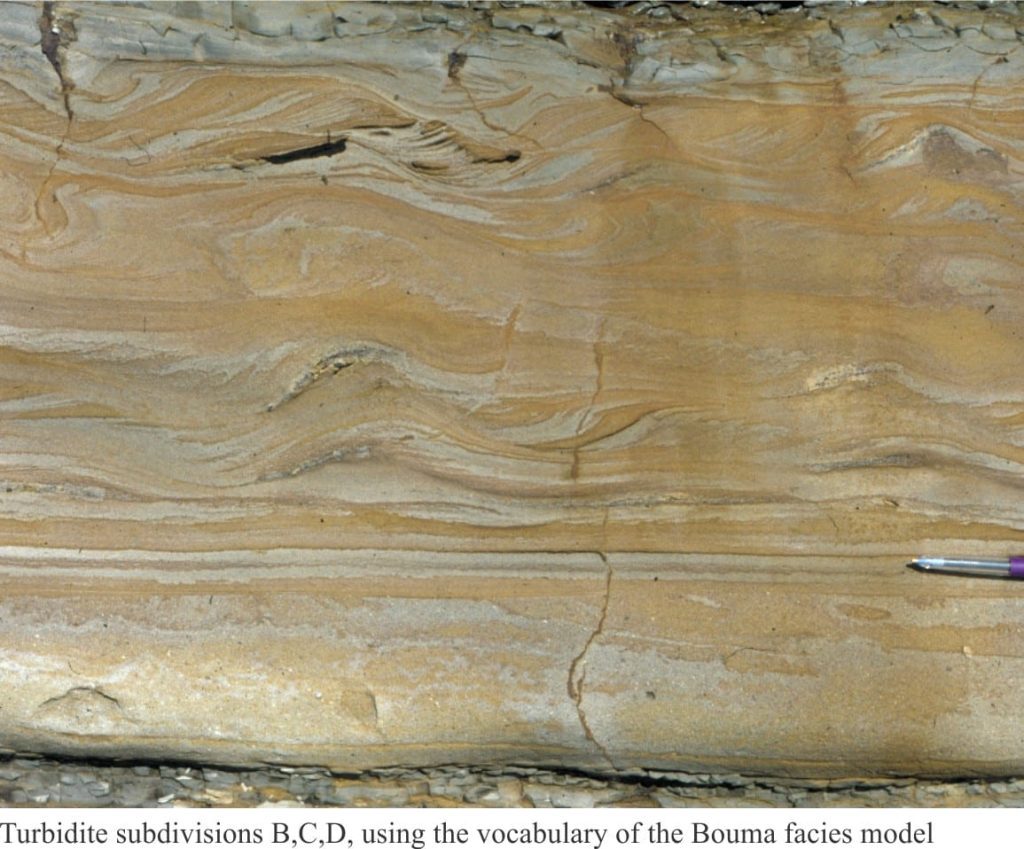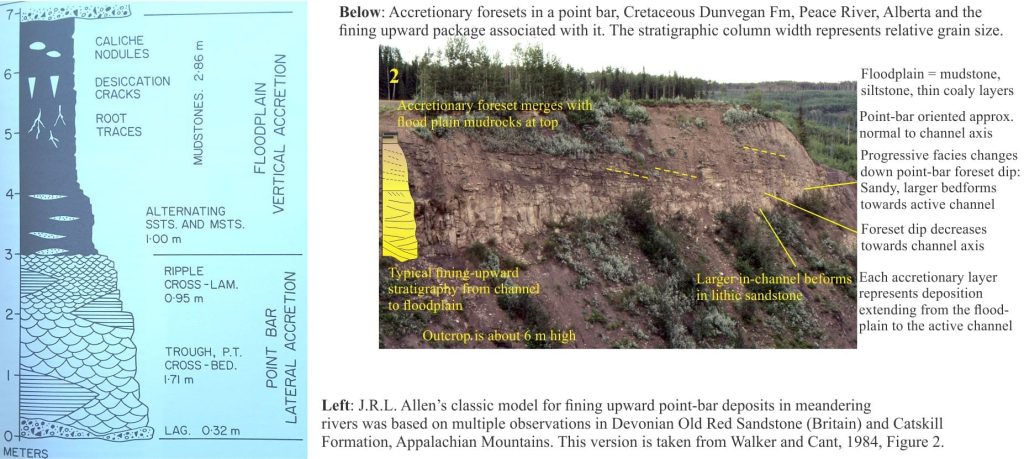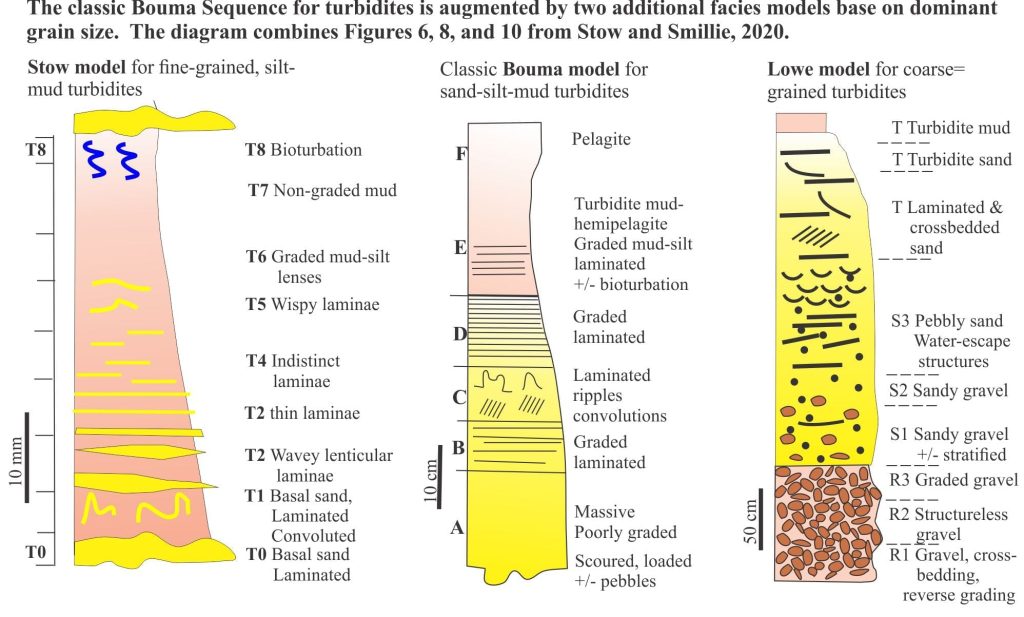Facies and facies models are fundamental tools for sedimentology and sequence stratigraphy.
This is part of the How To…series on Stratigraphy and Sequence Stratigraphy
For details of specific Lithofacies. try this link – It is continually updated.
Some background
Open almost any paper on sedimentology or sequence stratigraphy and the word “facies” will be incorporated into descriptions of data, formulations of arguments, and development of hypotheses and models. Facies and facies models are part of our vocabulary.
Facies, a Latin word for shape or appearance, was first used in a modern context by Amanz Gressly (1836) to describe the observable components of sedimentary layers. Gressly is an important figure in the history of conceptual stratigraphy – his name is frequently omitted from the list of geological icons, but it should stand beside the likes of Steno and Walther (I am as delinquent in this as anyone, having omitted him in my Stratigraphy Timeline. Fortunately, Cross and Homewood (1997) have resurrected his status – my guilt is assuaged.
Gressly intended facies to represent a reasonably objective description of sedimentary beds, including characteristics like texture, colour, sedimentary structures, and fossils. He recognized that certain facies were repeated throughout stratigraphic successions, that particular facies could morph into different facies along the lateral extent of a bed, and that there are vertical or stratigraphic repetitions of facies. Gressly also determined facies to be the product of depositional and biological processes, many of which operate today. Thus, he surmised that if one observed lateral facies transitions in a bed, then they could infer corresponding changes in depositional processes. The last observation here is particularly important because he realized that these lateral facies transitions could be projected through stratigraphic successions – preempting Johannes Walther by almost 60 years.
Today, the term facies encapsulates the essential physical, biological, and chemical attributes of rocks and sediment. It is both a concept and a thing – something we observe and describe using all the geological tools available, and a concept in the sense that we use these attributes to interpret ancient environments. Textbooks are one of the better places to find definitions of things like facies because the authors have, it is hoped, done their homework. Here is a concise definition from Gary Nichols’ textbook ‘Sedimentology and Stratigraphy’ – “A rock facies is a body of rock with specified characteristics that reflect the conditions under which it was formed” (p. 2). The expression “specified characteristics” is about as broad in scope as you want to make it, but commonly specifies:
- Lithology (e.g. sandstone, wackestone)
- Colour (e.g. red or green mudrocks)
- Texture (e.g. grain size, sorting, fabric)
- Sedimentary structures (e.g. crossbeds, post-depositional)
- Mineralogical composition (e.g. dolomitic, quartzose)
- Fossil content (e.g. micro- and macrofossils, trace fossils)
- Bed geometry.
Modern definitions of facies are pretty much the same as Gressly’s – we use facies as a tool for characterizing sedimentary rocks. However, modern usage commonly refers to facies in more genetic terms, for example fluvial overbank facies. In this context it is important to separate the descriptive attributes that define the facies (in this case they might include laminated mudstone and siltstone, ripple crossbeds, plant fragments), from the interpretation.
The scale of a facies is basically left up to the observer – it can be part of a bed, a whole bed, or several beds. The only real proviso is that common sense prevails – too many facies becomes unwieldy. One viable alternative is to subdivide facies into subfacies, but again their number and scale needs to confer pragmatic utility. This degree of practicability also applies to microfacies – a practice commonly used in carbonate petrography. This vocabulary has also been extended to lithofacies (rock-sediment attributes), biofacies (mainly fossils) and chemofacies (e.g. organic shale, or green shale (REDOX) facies).
The expression Facies Association is also a derivative of Gressly’s astute observations. We recognize that a particular facies is associated with other, unique facies, and that this association is commonly repeated throughout stratigraphic successions. For example, facies that describe fluvial overbank deposits will be associated with facies that define fluvial channels, swamps and peat bogs, paleosols, and cutoff channel meanders that become oxbow lakes. In fact, it is the associations of facies like these that provide the real clues to interpreting paleoenvironments. We can interpret a trough crossbedded sandstone facies as having formed under conditions of confined, or channelized flow. But on its own we cannot determine whether it was a fluvial channel, a tidal channel, or a distributary channel on a delta.
Like facies, certain facies associations are seen to repeat through geological time. Enter an important variation on this theme – Facies Models.
Facies Models
Models are simplified descriptions of a complex universe, a scaled-down version of some phenomenon; they allow us to visualise and interpret our observations within an established framework – that framework may be mathematical, conceptual (e.g. thought experiments), or empirical. Models allow us to predict outcomes where direct observations or measurements are not possible. For example, a numerical groundwater model will attempt to recreate existing hydrogeological conditions in an aquifer, then stress the system by tweaking certain variables to predict the possible outcomes of groundwater withdrawal. Likewise, facies models provide a kind of template to interpret and visualise sedimentary facies and facies associations.
Facies models became popular in the late 1950s and 60s. To an extent, the burgeoning number of facies models reflected the rapid increase in subsurface data gained from hydrocarbon exploration. Some of these models are still in use today; most have been subjected to modification. Two of the earliest models are the turbidite Bouma Sequence, and the Hydraulic Flow Regime that relates stream flow to sedimentary bedforms.
The Geological Association of Canada (now Geoscience Canada) in 1976 introduced the iconic series Facies Models, edited by Roger Walker. This set of papers, perhaps more than any others, brought facies models into the mindful living rooms of students of sedimentology and stratigraphy. The volume has been reprinted and re-edited several times since. Models are presented as ideal stratigraphic columns, block diagrams, and mathematical functions, that:
- Express general statements about a depositional setting (fluvial, aeolian etc.),
- Filter local sedimentary and stratigraphic variations that are encountered from one set of exposures to the next,
- Allow the prediction of facies and facies associations, that in turn
- Guide future analyses, observations, field work, and
- Act as a ‘Norm’ for all such deposits.
Along with point number 5 comes a warning (that applies to any kind of modelling), that observations should not be ‘forced’ into an existing model, via errors of omission or commission. Facies models are not cast-in-stone; if a model requires too much tweaking to provide meaningful comparisons, then it needs modification or replacement by a new model. Those who use facies models also carry the burden of avoiding pigeonholing of depositional environments. A case-in-point is Allen’s classic fining upward model for meandering river point bars, that remains a useful tool but should not constrain interpretations of lower sinuosity channels. Interpretation of ancient river systems does not depend on choosing between meandering or braided river models but recognizing that the models are end members of a spectrum of channel morphologies. Likewise, Arnold Bouma’s classic model (1962) allows geologists to make sense of turbidites, and at the same time guide the identification of sediment gravity flows models that deviate from the norm, as is the case for mud-dominated and coarse-grain dominated flows (Stow and Smillie, 2020 ).
George Box, a statistician at the University of Wisconsin Madison famously quipped “All models are wrong, but some are useful.” The utility of facies models is evidenced by the fact that, after 60 years, we still use them; perhaps we have learned to treat them with a healthy degree of scepticism.
Posts on models and modeling
Geological models: An introduction
Model dimensions and dimensional analysis
Other posts in this series on stratigraphy and sequence stratigraphy
Stratigraphic surfaces in outcrop – baselevel fall
Stratigraphic surfaces in outcrop – baselevel rise
A timeline of stratigraphic principles; 15th to 18th C
A timeline of stratigraphic principles; 19th C to 1950
A timeline of stratigraphic principles; 1950-1977
Baselevel, Base-level, and Base level
Sediment accommodation and supply
Autogenic or allogenic dynamics in stratigraphy?
Stratigraphic cycles: What are they?
Sequence stratigraphic surfaces
Shorelines and shoreline trajectories
Stratigraphic trends and stacking patterns
Stratigraphic condensation – condensed sections
Depositional systems and systems tracts
Which sequence stratigraphic model is that?
References and additional reading
J.R.L. Allen, 1965. A review of the origin and characteristics of Recent alluvial sediments. Sedimentology, v. 5, p. 89-191.
A.H. Bouma, 1962. Sedimentology of some flysch deposits. Elsevier, 168p. Contains the definition of the classic Bouma Sequence.
T.A. Cross, and P.W. Homewood, 1997. Amanz Gressly’s role in founding modern stratigraphy. Geological Society of America Bulletin, v. 109, p. 1617-1630.
A.D. Miall, 2014. Fluvial Depositional Systems. Springer.
G. Nichols, 2009. Sedimentology and Stratigraphy. 2nd. Edition. Wiley-Blackwell, 419 p.
C. Paola, 2000. Quantitative models of sedimentary basin filling. Sedimentology, v.47, p. 121-178. A millennium review
H.G. Reading, 2001. Clastic facies models: A personal perspective. Bulletin of the Geological Society of Denmark, v. 48, p. 101-115.
R.G. Walker (Editor), 1976. Facies Models 1: General Introduction. Geoscience Canada, v. 3, Number 1. The original Facies Models papers are available in PDF from this Geoscience Canada website.
R.G. Walker (Editor), 1984. Facies Models. 2nd Edition. Geoscience Canada Reprint Series 1.
R.G. Walker and D J. Cant, 1984. Sandy fluvial systems. In, R.G. Walker (Editor), 1984. Facies Models. 2nd Edition. Geoscience Canada Reprint Series 1, p. 71-89.



